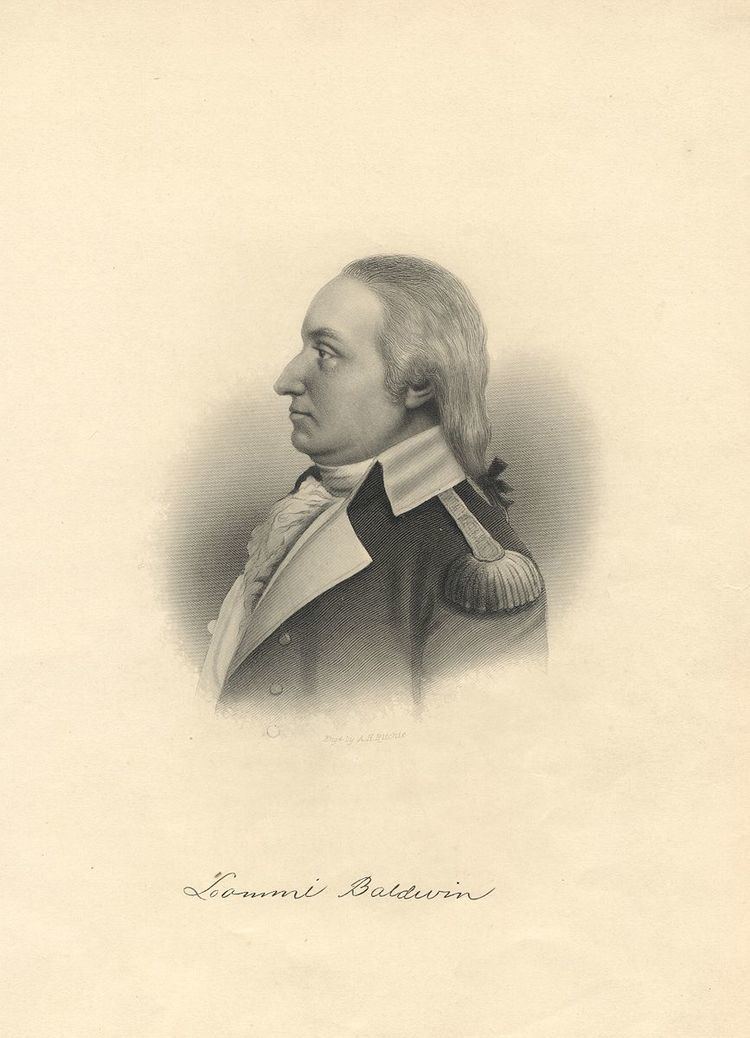Active 1775–1777 | ||
 | ||
Engagements | ||
The 26th Continental Regiment (previously known as Gerrish's Regiment and later known as the 9th Massachusetts Regiment) was an infantry unit of the Massachusetts Line during the American Revolutionary War. Gerrish's Regiment was raised in the early days of the war, and the regiment underwent name changes as the Continental Army was reorganized in 1776 and 1777. From 1777 onward, the unit was known as the 9th Massachusetts Regiment.
Contents
1775 history
In January 1776 the 26th Continental Regiment was organized from the remnant of Gerrish's Regiment, also known in the 1775 army establishment as the 25th Massachusetts. It was at first commanded by Colonel Samuel Gerrish, of Newbury, who was dismissed from the service on August 19, 1775. Command of the regiment passed to its next senior officer, Lieutenant Colonel Loammi Baldwin, of Woburn. Baldwin commanded the 25th Massachusetts Bay Provincial Regiment in 1775 during the Siege of Boston. To form the new unit, the old regiment had to be reduced from ten companies to eight. Command of the newly formed 26th Continental Regiment was given to Baldwin, who was promoted to the rank of Colonel on January 1, 1776.
1776 history
In a report dated January 8, 1776 at Cambridge Camp, Colonel Baldwin reported the following roster of officers for his newly organized regiment, in addition to himself and his second in command, Lieutenant Colonel James Wesson. He also noted that he had no chaplain. Each line of this report represents a company of the regiment.
Baldwin's 26th Continental Regiment was ordered to join the Main Army, moving to New York City in April 1776 and becoming part of Heath's Brigade there. On August 12, 1776 the 26th Regiment was transferred to Clinton's Brigade. The regiment's strength report for September 1776 showed 23 officers, 35 non-commissioned officers, 5 staff officers, and 255 privates.
The regiment saw action on Long Island and distinguished itself at the Battle of Throg's Neck and the Battle of Pell's Point, holding off a much larger British force to allow George Washington to withdraw from Manhattan to White Plains. The regiment then joined Washington in White Plains for that battle.
The 26th Regiment also served at Trenton. On the night of December 25, 1776, in the face of a violent and extremely cold storm of snow and hail, General Washington and his army crossed the Delaware to the New Jersey side, and fought the Battle of Trenton. Baldwin and his regiment participated in both the crossing and the fight.
1777 reorganization
In 1777, the 9th Massachusetts Regiment was formed by consolidating the remnant of the 21st Continental Regiment with the remnant of the 26th Continental Regiment. Colonel Baldwin was forced to retire due to ill health. The new commanding officer of the 9th Regiment, James Wesson, had been a major of Gerrish's Regiment in 1775 and the lieutenant colonel of the 26th Continental Regiment in 1776.
The regiment had two, successive commanders: Colonel Wesson, from November 1, 1776 to January 1, 1781; and Colonel Henry Jackson, from the latter date to January 1, 1783. The regiment was a part of Learned's Brigade, which consisted of the 2nd Mass, 8th Mass, the 9th and, some say, the 1st Canadian Regiment. When in battle formation, the regiment was always positioned in the second line of the left wing, between the 3rd Mass and the 6th Mass. Overall command was by Major General Stirling.
The regiment served in what was known as the Northern Department during the war. It participated at Fort Stanwix, Saratoga and Valley Forge. At Valley Forge (1777–1778), under the command of Col. Wesson and assisted by Lt. Col. James Mellen, it was incorporated into Major General DeKalb's division.
It is known that the issued regimental coat should have had red facings but, due to the shortage of dyed material, buff facings were most likely substituted. Recent information suggests blue coats with white buff facings, green or plaid waistcoats, buff trousers and buckled shoes. Research of the regiment is ongoing.
Equipment
The 26th Regiment uniform was brown coats with buff facings similar to the British. They wore waistcoats and breeches of white cloth. The 26th was one of the first regiments of the Continental Army to outfit a grenadier company. Under the command of Captain Thomas Mighill, the company wore the traditional grenadier's mitre cap. One of these caps has survived in the Smithsonian collections. The Roman numerals 'XXVI' and the cipher 'GW,' for George Washington, are embroidered on the front. The regiment was referred to as the "George Washington Regiment." Mighill rearmed his grenadiers in July 1776 with Short Land Pattern Muskets and bayonets that had been captured from the British.
Legacy
The Ninth Massachusetts Regiment is a group of revolutionary war reenactors. The group formed in 1975 in Braintree, Massachusetts, under its original name the Braintree 3rd Volunteer Militia. During the "great event" celebration, of July 4, 1976, a call went out to recreate the major events of the revolution. The group acquired the correct clothing and equipment of the American Continental Army.
